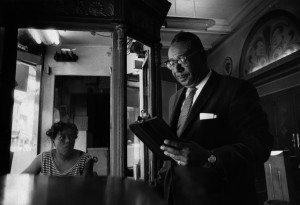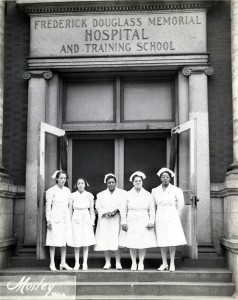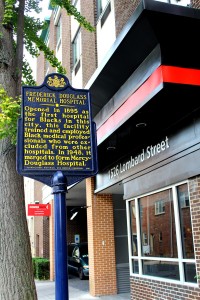Black Philly After The Philadelphia Negro
Along with Chicago’s Bronzeville, Pittsburgh’s Hill District, Washington, D.C.’s U-Street/Shaw area, Los Angeles’s Watts, and New York City’s Harlem, Philadelphia’s black Seventh Ward served as a major port-of-entry for southern black migrants during the Great Migration.
At its height, the black Seventh Ward contained close to 15,000 black residents along with shops and myriad cultural institutions.
As W. E. B. Du Bois reported in his classic 1899 study The Philadelphia Negro, the black Seventh Ward was “in the centre of the city, near places of employment for the mass of people and near the centre of social life,” leading people to “crowd here in great numbers.” Excited by the opportunity to research the neighborhood, he was struck by the diverse black population, the extreme poverty and seemingly ever-present violence. “Murder sat at our doorsteps, police were our government, and philanthropy dropped in with periodic advice,” he wrote.
Du Bois and his wife Nina arrived in Philadelphia in the autumn of 1896, amid “an atmosphere of dirt, drunkenness, poverty, and crime.” Commissioned by local political leaders and scholars, Du Bois analyzed black life in Philadelphia, demonstrating “how this class of people live; what occupations they follow; from what occupations they are excluded; how many of their children will go to school; and to ascertain every fact which will throw light on this social problem.”
Du Bois dove into his research, conducting demographic analyses, interviews, and participant-observation. Dressed in a well-fitted suit and bow tie, he spoke with over 5,000 black Seventh Warders, combing through archives. Du Bois found that the answers to key questions about urban inequality and the daily lives of black cityfolk could be found by understanding their neighborhoods. The problems of African-Americans in Philadelphia (and elsewhere) were the result of centuries of prejudice, enslavement, and discrimination.
Urban black Americans, however, were not simply victims of the vast changes impacting American cities throughout the twentieth century—urban renewal, deindustrialization, the New Deal, the War on Poverty, and general urban disinvestment. Nor were they passive bystanders who watched the city change from the windows of their row homes. Black Philadelphians were and are agents of urban change—citymakers.
Up South
What happened after W. E. B. Du Bois left Philadelphia? Did his research and policy recommendations impact the Seventh Ward? What was the fate of this historically black neighborhood, and others like it? Curious about these questions, I looked at a pivotal period after Du Bois’ study—the 1920s through the early 1940s. Looking at this period allows us to gauge the relationship of Philly’s black residents to the progressive politics that shaped urban New Deal policies and coalitions. This period also offers a historical window into the shifting allegiances of black Americans, and their retreat from the Republican Party and embrace of the Democratic Party.
Examining housing reform and the development of public housing in the city, I combed through public documents about local and national housing policies and changes, events in the black Seventh Ward, voting results, and local and national political campaigns. I wanted to gain a better sense of the social, economic, and political conditions of the time, and the various stakeholders and players in reform efforts.
What I found is that three decades after Du Bois left Philadelphia, black and white community organizations commissioned a study of “Negro migrants” in the black Seventh Ward. They found insufficient water supply and toilet facilities, defective sanitary equipment, overcrowding, leaky roofs, plaster and paper falling off the walls, and windowless rooms. Du Bois had earlier documented similar deprivations: “Of the 2,441 families only 334 had access to bathroom and water-closets,” he wrote. “Even these 334 families have poor accommodations. Many share the use of one bathroom with one or more families. Most of these houses have to get their water at a hydrant in the alley, and must store their fuel in the house.”
Landlords responded to the increased black population by refashioning apartments and rooming houses, dividing existing residences into several “new” rooms or apartments—many of which of lacked heating, bathrooms, or adequate plumbing. The persistence of poor housing decades after The Philadelphia Negro suggested a pattern of racial segregation and exploitation that has typically been associated with the South. The Philadelphia Tribune, a local black newspaper, dubbed the black Seventh Ward “Hell’s Acre.” Indeed, Philadelphia represented what historian Matthew Countryman refers to as “up south” racial oppression.
Black and white leaders attributed the neighborhood’s deplorable conditions to the supposed “backwardness” of southern black migrants, suggesting that housing conditions would improve once new arrivals were taught “how to live in a city.” Because of this Republican opposition to intervention, the Democratic Party became more and more appealing to poor and working class black residents.
The Republican Mayor J. Hampton Moore declared that Philadelphia “was too proud to have slums” and that people were “merely living within their means.” At the onset of the Great Depression, such a fiery statement would lead to a highly competitive mayoral race in 1935. Having witnessed the power of the black voting bloc in the election of President Franklin Delano Roosevelt, Philadelphia’s Democratic mayoral candidate John “Jack” Kelly used the deterioration of the black Seventh Ward as a part of his 1934-1935 political platform. He assailed Republican leadership for continued inaction in the black Seventh Ward, capitalizing on a political opportunity Du Bois had foretold in The Philadelphia Negro: “Any worthy cause of municipal reform can secure a respectable Negro vote in city, showing that there is the germ of an intelligent independent vote which rises above even the blandishments of decent remunerative employment.”
The Philadelphia Tribune supported Kelly’s mayoral bid and focus on black housing, running a series of investigative reports on the plight of the black Seventh Ward. “Living conditions in [Hell’s] Acre are not based on the house or apartment unit. Here the basis of any examination is the single room… you find whole families living in ONE room, not two or three or four rooms,” the Tribune reported. Black Philadelphians also embarked on a successful letter-writing campaign, which led to an allocation of $10 million from the secretary of the federal Public Works Administration for slum removal and new housing construction. But a tragic event would challenge this pattern of development.
An American Tragedy
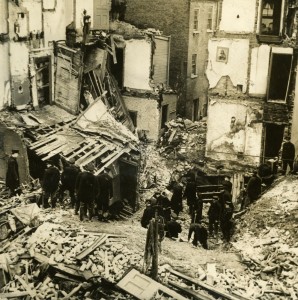
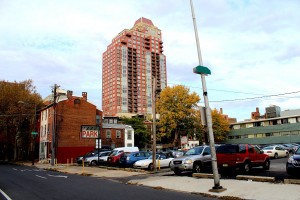
On the evening of December 19, 1936, Lucy Spease ate dinner with her three children—Bernice, age 13, Samuel, age 6, and Helen, age 5—in her small but homey second floor apartment on South 15th Street. The Seventh Ward apartment was cold. Cracks along the walls gave way to the wintry air, and it was common practice for residents to sleep, eat, and cook in their winter coats. All of Spease’s neighbors, including those in the apartment building next door, had repeatedly complained to the landlord, a white man by the name of Abraham Samson, about their poor living conditions.
That evening, a neighbor named Raymond Blackwell confronted the landlord, perhaps hoping to see repairs made before Christmas. In his plea to Samson, Blackwell exclaimed: “the walls on the second floor front room are bulging at least a foot and a half and the paper in the kitchen is falling off and the walls have begun to crack.” As the men spoke, Spease was busy tucking her children into bed. Soon after, she felt the walls shake. Plaster fell from the ceiling in huge chunks and, in a flash, the floor caved beneath her. Blackwell, believing his words might have finally pushed Samson to action, arrived home to find that the building had been reduced to rubble.
All that was left of the building was a stack of ruins more than a story high. Nearly 35 people were caught inside. Lucy Spease was found dead near the bodies of Bernice and Samuel. Helen, Spease’s youngest daughter, died the following day. All told, seven people were killed, and more than two dozen were injured. The site took several days to clear.
The tragedy became the catalyst for an unprecedented period of housing reform and construction in Philadelphia, including several housing projects designed to supply affordable housing to the city’s poor and working class black residents.
The day after the building collapse on South 15th Street, Crystal Bird Fauset, an emergent Democratic leader, led a committee of concerned black residents and leaders through the site. Fauset took to the editorial pages of another black newspaper, the Philadelphia Independent, after the visit: “Time after time, these housing needs have been pointed out to us,” she wrote passionately. In spite of earlier reports and surveys “that reported that something needed to be done, and be done quickly,” Fauset said, “the houses crashed and killed several women and little children.”
“We women who make the homes of land, who revere the home, must act as well as merely observe or voice an opinion,” she proclaimed. “Once sensing a situation, we must not wait on others to meet the need, whether they be officials or other [black] people… we must pitch in and compel action.” Fauset tried to empower black women, remind residents that these housing problems were both dangerous and nothing new, and broaden the scope of the tragedy, appealing to black neighborhoods throughout the city.
Unfit For Habitation
Within a couple of weeks of the collapse, Mayor Wilson began razing dilapidated housing in the black Seventh Ward. Using the $10 million acquired through the earlier letter writing campaign, Wilson placed “Condemned, Unfit for Habitation” signs on many properties, with black Seventh Warders receiving his removal notices—which effectively left them homeless—as adding “insult to injury.” A series of spontaneous protests broke out and later prompted the development of the black-led Philadelphia affiliate of the National Negro Congress and Tenants League. Such activism halted Wilson’s forced evictions and facilitated the development of the Philadelphia Housing Authority (PHA) in 1937.
Charged with new housing construction, the PHA received $20 million from the United States Housing Administration. It targeted two neighborhoods in North Philadelphia as the sites for what would become the James Weldon Johnson and Richard Allen Homes. Designated as black housing, both projects would be built under what became known as the “racial composition rule.” Employed in Atlanta, Chicago and other cities, this rule required that housing projects be built in already heavily black areas, and that their residents should reflect the existing racial composition of the surrounding neighborhood. Aware of the possibility that new housing would be located in North Philadelphia, some black Seventh Warders migrated to North Philadelphia between 1937 and 1940, taking up residence with relatives and friends who already lived in the area.
This migration not only shrunk the population of the black Seventh Ward, but also led to the decline of its key black institutions. Most notably, both the historic St. Thomas African Episcopal Church (founded 1793) and Frederick Douglass Memorial Hospital (founded in 1895) were forced to relocate to West Philadelphia. As the rector as St. Thomas intimated: “The church at 12th and Walnut streets was removed from its congregation and had no community in which it could effectively work.” Without a robust black community, neither institution could be widely effective in the black Seventh Ward.
As Du Bois had observed in The Philadelphia Negro, churches such as St. Thomas were initially established as safe havens, providing protection from racial violence as well as spiritual guidance. The social and real protections of black institutions wedded black Philadelphians to the Seventh Ward: “the Negro [who] ventures away from the mass of his people and their organized life… finds himself alone, shunned and taunted, stared at and made uncomfortable.” In this way, the decline of key institutions was a deep reflection of the dispersal of residents and the rising prominence of other black enclaves in the city.
The fact that the black Seventh Ward was not a central focus in housing construction was not lost on those who remained in the neighborhood. Reverend C. A. Roach, rector of St. Peter Claver Catholic Church, warned residents against the “political ballyhoo and political bluffs” of city leadership and argued: “We don’t want Mayor Wilson going through the streets telling what he’s going to do. Nothing has been done since these buildings collapsed, carrying to their deaths seven persons. Now we want some thing done.” Such calls would go unaddressed, as the new housing efforts spurred by the deaths of the Spease family would be confined to a different neighborhood, providing incentives to leave the black Seventh Ward.
By 1940, the Johnson and Allen Homes were slated to be fully occupied. Rejected families attempted to garner a spot in the newly proposed Tasker Homes, whose primary occupants were to be whites. Their applications caused some short-term friction until black leaders worked to quiet such dissent by reminding disgruntled families how the status quo actually favored black Philadelphians.
Black Citymakers
Another short battle ensued when the PHA tried to sell the Allen Homes to the federal Defense Housing Administration. In response, black leaders wrote to President Roosevelt: “Sir, take immediate cognizance of the fact that the United States Housing Administration has diverted the use of these homes from their original purposes at the expense of the low income group, who are least able to obtain decent housing even in normal times and not able at all in these times.” They urged him to act “in the interest of these persons who cannot obtain decent housing within their capability to pay.” He reversed the PHA’s decision, and by 1942, the Allen Homes were fully occupied by black families.
But the housing boom came to an abrupt end with the election of Republican Mayor Robert Lamberton in 1939. “Slums areas exist,” said Lamberton, because “some people are so utterly shiftless that any place they live becomes a slum.” And with that progressive housing reform in New Deal-era Philadelphia was halted.
Today, over a century later, nearly all the churches, stores, and social clubs that lined blocks of Lombard and South Streets, in what was once the black Seventh Ward, are gone. The site of the building that collapsed on South 15th Street nearly 90 years ago is now a parking lot. Replacing them are newly built residences and businesses catering mainly to white residents. The black history of the neighborhood is recalled in myriad plaques commissioned by the Historical Society of Pennsylvania to mark the neighborhood’s rich black history. Indeed, this historically black neighborhood is no longer.
And yet this history suggests that black residents of Philadelphia’s Seventh Ward were not simply the passive witnesses of change. They were actively involved in housing reform efforts, shaping the ways local and federal officials addressed problems of housing and other urban issues. As Du Bois noted over a century ago, black residents were keenly aware of their conditions, and they acted individually and collectively to ameliorate them. Black residents have long been citymakers, and a force for progressive change.
recommended resources
Du Bois, W. E. B. The Philadelphia Negro: A Social Study (University of Pennsylvania Press, 1899). Provides an in-depth analysis and portrait of Philadelphia’s black Seventh Ward from 1600-1897, the first monograph of its kind in American sociology.
Countryman, Matthew. Up South: Civil Rights and Black Power in Philadelphia (University of Pennsylvania Press, 2006). Provides an in-depth analysis and portrait of black politics and protests in Philadelphia during the Civil Rights and Black Power eras.
Katz, Michael B. and Thomas J. Sugrue. W. E. B. Du Bois, Race, and the City: The Philadelphia Negro and Its Legacy (University of Pennsylvania Press, 1998). Provides an extensive interdisciplinary consideration of the various implications of The Philadelphia Negro for the study of race, history, and urban America.
